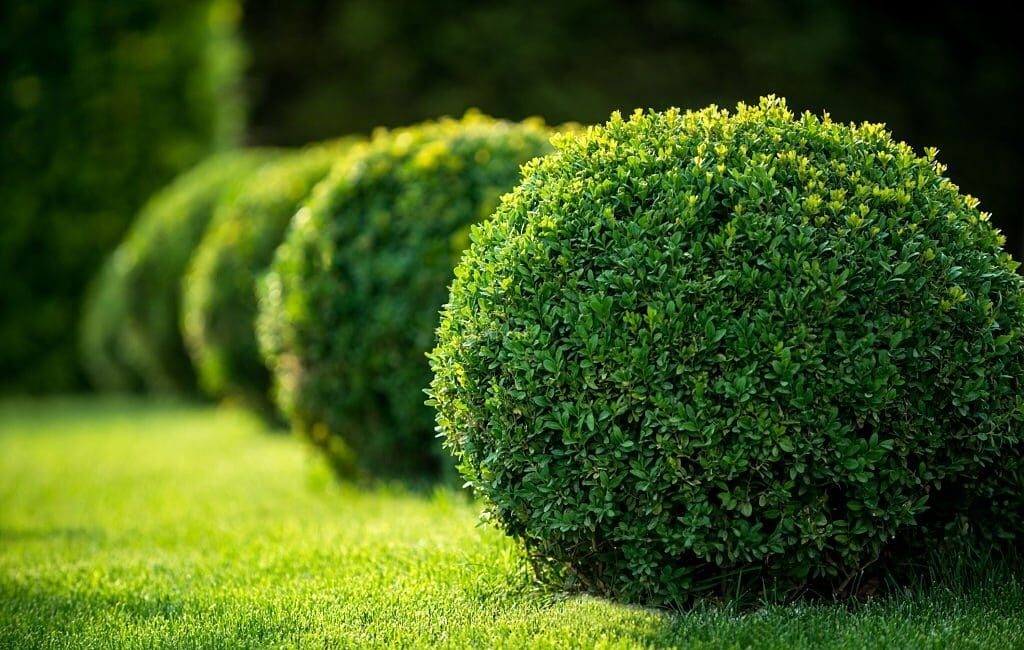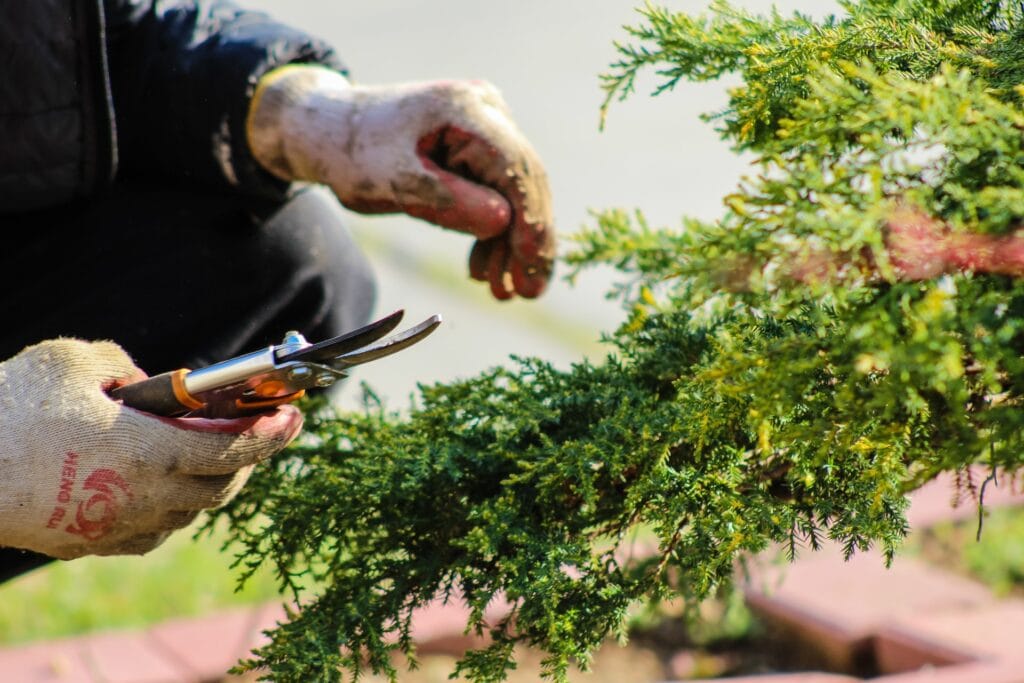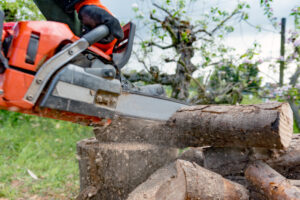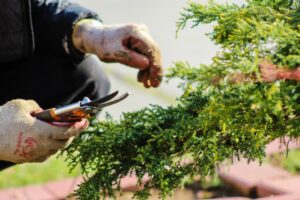Hedge trimming can be a peaceful and calming activity for some people. One that we take advantage of when the weather is warmer and that maintains the vitality and vigour of our hedges. On the other hand, it is possible to prune your hedge quite so much, and if this occurs, you run the risk of killing your hedge or creating damage that is irreversible.
If this is the case, what is the proper method for trimming your hedge, and if there is such an issue as having too much of anything, how much of it should be removed? It is possible to feel overwhelmed by the prospect, but the best part is that it is not quite as challenging as it appears to be. This article will provide you with all of the hows and whys that are necessary to make your hedge look fantastic without any stress.
Regarding maintaining their lush appearance and good health, hedges are no different from any other plants in this regard. For them to remain in their allotted space, they require both formative and general maintenance trimming. It is only natural for the amount of time needed to prune hedges to differ from one another, given that hedges are often composed of numerous species of trees and plants. In the same way that there is an "ideal moment" to prune your trees, there is also an "ideal time" to trim your hedges.
The first 2 to 3 years following the planting of a hedge are the ideal times to execute formative trimming. After then, it is typically done either throughout the winter or the beginning of the spring. The kind of hedge you have should determine the frequency and extent of the annual pruning.
Hedge trimming is done with the intention of preventing diseased or dying branches from causing harm to nearby plants and people. The removal of these branches enables the blossoming of the flowers or fruits that are contained within the hedge. When pruning a hedge, as opposed to doing routine maintenance trimming, the goal is not to slow the hedge's growth but rather to encourage it. Another reason gardeners prune their hedges is to eliminate branches that are infected with disease or that have been invaded by pests.
When to Trim Your Hedges
Formative pruning is something that needs to be done to hedges for the first few years after they have been planted. This takes place during the colder months of winter and the beginning of spring. Following this, the maintenance pruning is kept relatively haphazardly and is only performed once a year to ensure the plant's continued good health. On the other hand, if you want to shape your hedges more formally, you should prune them three times per year.
Why There Are Certain Trimming Times
It is recommended that you refrain from pruning hedges between the months of March and August because this is the time of year when birds typically nest. This is because it has the potential to annoy birds that are nesting and force them to leave their young and their nests.
We recommend that you prune most of your hedges during the later part of the dormant season, which is late winter or early spring. There is one important exception to this rule, and that is if you have hedges that blossom in the early spring, you should trim those hedges just after they bloom.
These should be pruned in the late winter or the early spring:
- Hedges made of boxwood
- Potentilla rose of Sharon Japanese spirea rose of Sharon
- Camellia
- Conifers and butterfly bushes
Immediately after they have finished blooming in the spring, prune these:
- Azaleas
- Bushes of the genus Loropetalum
- Mock orange
- Lilac
- Additional early spring flowering plants
- Forsythia
The explanation for this is straightforward: many blooming shrubs bloom on the growth from the previous year, which is often referred to as "old growth" or "old wood." The buds are formed for the following year's crop not long after the flowers have died off. It would be best if you pruned them promptly after the blooms have turned brown and before they set their buds for the following spring. This should take place as soon as the flowers have turned brown. If you wait until the end of winter or the beginning of spring to prune these bushes, you will remove the flower buds that will bloom in spring.
Plants that produce flowers on new growth can have their branches cut during the late dormant season because they have not yet begun to produce new growth or new buds at this point.
Another notable departure from the rule is what gardeners refer to as the "three Ds" of pruning. At any point during the year, you can prune away sick, damaged, or dead branches on your tree if you discover them.
Before you plant any new hedges, be sure to check with your homeowner's association as well as the local regulations. Most HOAs have laws that dictate where and how high a hedge can be placed on a property. There are ordinances in effect in certain cities that are very similar to those.
How to Trim Your Hedge without Killing It
First and foremost, you should make sure that the hedge trimmer you choose has high quality. To obtain a clean cut and make certain that nothing gets snagged or damaged in the procedure, you want to be sure that it is capable of cutting through branches of varying thicknesses.
Trimming Techniques
For bigger areas, a hedge trimmer is necessary; however, a pair of shears that can be carried in one hand is ideal for trimming smaller sections that require more precise work. Furthermore, numerous amazing garden trends involve hedges that you might wish to reproduce in your own garden.
Formal hedges need to be cut symmetrically and are extremely simple to manage overall. To accomplish this, hold the shears in a position that is parallel to the hedge line.
You can make a template out of cardboard or wood to use as a guide for your shears while you trim the head of the hedge. This will help you get a clean cut every time. Similarly, you may create impressive straight edges by tying a taut rope between 2 canes and then pulling them tight.
The process of cutting back an informal hedge is quite similar to the process of trimming a regular hedge. It makes room for new growth and contributes to the continued visual appeal of your landscape. It goes without saying that you should be sure to remove any plants or shoots that have become dislodged, but if you have perennial hedges, you must also avoid damaging the leaves so that the plants can collect enough nutrients.
Be extremely cautious while performing severe pruning on a hedge, as this can result in the death of the hedge because you will be cutting back to the old wood, and the hedge will not be able to recover from this. In a similar vein, chopping solely on one side of it can leave it imbalanced and hefty, both of which can lead it to pop out of the surface.
When you are doing your pruning, make sure that you remove one-third of the excellent wood back. This will stimulate new development and keep the plant healthy. It's important to give the hedge time to recover while also ensuring that it may continue to get all of the nutrients it needs.

How to Maintain Hedges
- Shearing must be accompanied by the essential step of hand-pruning.
When branch tips are removed from hedges with shears—whether power trimmers or hand-held pruners with long, scissor-like blades—the result is a neater hedge and more bud growth nearby.
However, when buds develop, a shrub may become so dense that sunlight is unable to penetrate it, so inhibiting growth on the interior. The end effect is a hedge that grows in size but appears lifeless on the inside. The right kind of pruning lets more light in and helps you to keep shrubs from growing to unmanageable proportions by thinning them out.
By cutting the hedge repeatedly, bypass hand pruners make an opening in the hedge that allows light and air to pass through. Then, go inside the plant and snip one or two branches at a 45° angle, just above a nub or leaflet that is growing in the way that you want to encourage the plant to develop. Do this every few feet.
If a hedge is old and has become overgrown, you will need to perform some regeneration pruning on it, utilising the rule of three years. To begin, take up to a third of the stems that are the thickest at the base of the plant and remove them to encourage new growth. Do this the following year and the year after that. As a result, you will have a shrub that is in better health and smaller in size.
- It is best to prune in the winter.
In the best-case scenario, hedging should be pruned in the late winter, when the plants are dormant and have not yet formed buds. This is especially true if you intend to cut back significantly. Roger argues that you should avoid letting the buds open before performing the pruning since you want the plant's energy to be directed toward developing new growth in the areas where you want it. If you remove the buds from a plant, you are preventing the plant from recycling its spent energy. As a result, it will take more time for the hedge to become full.
Evergreens, in particular, need to be pruned early in the season. Because evergreens are typically slower-growing than other types of plants, they are more likely to have bare spots (where interior cuts have been made) and discoloured tips (too yellow) well into the summer, when new growth begins to emerge.
Deciduous hedging plants that grow more quickly, such as spirea, privet, and viburnum, are more tolerant of human error. Waiting until the day after blossoms have turned brown is the cardinal rule of trimming flowering shrubs. This allows the plant to have time to form buds for the following year, regardless of whether it flowers on the wood from the current season or the wood from the following season.
- Hedgerows ought to widen out toward the bottom and taper off toward the top.
If they are allowed to grow unchecked, most types of hedges will begin to spread out towards the top, where they are exposed to the most sunlight. This creates a V-shaped canopy that casts shadows on lower branches, causing those branches to generate ever-decreasing amounts of foliage. Gardeners advise that the V shape should be inverted before it is used. Therefore, regardless of whether the top of the sheared hedge is flat, pointed, or rounded, the bottom of the hedge should always be broader than the top of the hedge.
When you share, begin at the bottom and work your way up to the top. You may also run a string line between the stakes to create an even line along the top for ultimate precision cutting, but most gardeners prefer to rely on their eye to create a more natural appearance. This is because he wants the cut to look like it happened naturally.
It is important to keep in mind that once you have buzz-cut the top of a plant, it will not shed snow as easily, which makes it more susceptible to snow damage (broken branches). Be sure to use rope or chain lock (plastic tree-guying material) instead of hose-covered wire, which can wrap the trunks of the trees if left on for too long. Additionally, tall hedges advantage from being tied up for the winter.
- Before you start planting, you need to make a decision about the height and width of your hedge.
Choose plants that lend themselves to producing a hedge, which means that they naturally grow erect and tight—the terms "columnar" or "fastigiate" in the name imply that kind of growth habit—if you are starting from scratch, choose species that lend themselves to making a hedge.
For use as formal hedges, such as privet, yew, and boxwood, these shrubs will also need to be able to withstand shearing and frequent pruning. A minimum width of three feet is required for a hedge in most cases. In terms of height, trimming your hedge so that it is almost at eye level will make it simpler to do so; alternatively, you need to be prepared to use a ladder to reach the higher areas of the hedge.
Before you begin planting, it is in your best interest to determine the height and width of the hedge you wish to create. Research the growth pattern of any plant you wish to use as a hedge, then select a kind that will stay within the available area. In that case, your efforts to trim the hedge down to size will be like pushing uphill against a strong current.
The western arborvitae, juniper, eastern red cedar, hemlock, cypress, fastigiate white pine, and some types of holly are all excellent candidates for larger, more naturally shaped evergreen hedges that require less trimming. Other options include some species of holly. Flowering shrubs such as forsythia, crape myrtle, hydrangea, lilac, rose of Sharon, or rugosa roses could be used to create informal hedges in areas where it is not necessary to have foliage present all year round.
- Make sure you know the distinction between a hedge and private plants.
Expecting a hedge to provide a significant amount of privacy or to obstruct an undesirable view is unrealistic. In most cases, hedges are trimmed to a height of between 6 and 8 feet, although privacy plantings can reach heights of up to 30 feet. Generally, screen plantings are considerably larger as well, and they are made up of a variety of deciduous and evergreen trees, shrubs, and perennials that are spaced out in a staggered pattern to provide a natural appearance. We recommend letting a hedge function as it was intended: as an aesthetically pleasing shrub border that completely covers your yard and unifies the landscape. "Start looking at large trees if you want to maintain your privacy."
Top 10 Our Tips for Trimming Hedges
- Maintain its thick and solid consistency
Small birds like thrushes, finches, robins, hedge sparrows, and wrens can feel safe breeding and roosting in your hedge since the branches are so closely interlaced with one another. Magpies, crows, pigeons, and squirrels have the propensity to congregate in areas that have open hedges. Holly is an excellent choice for use as a hedge plant since it grows into compact, dense shrubs that offer superior protection during the colder months.
- When to cut the rope properly?
If possible, postpone the task of cutting your hedge until the winter season. Throughout the winter, birds, such as fieldfares, redwings, and other thrushes, rely on the berries and fruits that grow on hedgerows as a vital food source. The earlier you start cutting, the less food there will be to help these birds and other forms of animals survive during the harshest part of the year. If you must cut during the bird breeding season (which runs from March 1 through August 31), do so only if it is absolutely necessary.
- Be careful not to cut too frequently or too tightly
Even though cutting is required to maintain the thickness of a hedge, cutting it back to the same point each year will result in very few blooms and berries being produced by the hedge. Therefore, make an effort to prune the hedge no more frequently than once every 2 - 3 years, or at each trimming, allow some of the foliage to expand outward and upward. One further possibility is to chop away just one side or the head of the tree every year. If you have to trim your hedge regularly, try to leave some of the berry- or fruit-bearing trees alone to mature. A single mature hawthorn tree can yield as many berries as 200 meters of hedge that is taken down annually.
- Promote the growth of natural shrubs.
The shrubs that are native to Britain provide a home and food for a greater variety of bugs and other animals than do shrubs that have been brought in from other countries. Include a variety of plant species that will produce food at different times of the year. Willows and blackthorns produce nectar early in the year, while hawthorn, bramble, and rose flowers in the summer and berries in the fall. Ivy produces nectar in the fall and berries in the late winter.
- Plant flowers and grasses around the base and along the boundaries of the area.
Many different kinds of species can thrive in hedgerows when there is an abundance of plants at the bottom. Flowers such as primroses and knapweed give pollen and nectar to bees and other helpful invertebrates, while tussocky grasslands offer safe zones for beetles, spiders, and other insects of a similar nature throughout the winter months. Animals such as frogs, toads, newts, and lizards find food, cover, and potential hibernation sites in the dense foliage at the base of hedgerows. Even the hedgehog appreciates a nice, thick cover!
- Take care of the trees you have or plant some new ones.
If you have the space, planting large mature trees, particularly indigenous species such as oak, ash, and beech, will significantly enhance the quantity of wildlife that uses the hedge. The insects will gather around the crown and beneath the canopy, offering an abundant food source for the birds and bats that live there. Small trees such as holly, rowan, and crab apples are quite valued, particularly for the blooms they produce and the abundant fruit and berry crops they provide.
- Bringing new life to your hedge
By pruning hedges at regular intervals over the course of several years, you may ensure that they retain their bushy appearance, but they will eventually become more open at the base. If this occurs, they should be pruned back to within a few inches of the ground so that they can produce a fresh crop of stems and start a new cycle of healthy development. (This strategy won't work for conifers because they don't sprout new growth after being cut down to the ground.)

- When constructing a new hedge, it is important to use plants of the appropriate species.
Many of the issues that arise with hedges, such as disagreements between neighbours, may be traced back to using fast-growing plants to get results more quickly. These plants result in hedges that quickly grow excessively tall and are hard to maintain. Before selecting the bushes and trees for your hedge, you should consider both the reason you desire one and the location.
- Connect the hedge to other areas that are suitable for animals, and fill in any gaps.
Many different kinds of animals steer clear of open areas because they put them at risk of being ambushed by other animals. If, on the other hand, your hedge is connected to other hedges, woods, or a pond, then it will serve as a safe passageway for wildlife to travel through both rural and urban areas. Many different kinds of animals, including bats and dormice, steer clear of spaces of any size.
- Investigate the hedge you have.
Maintain an eye on your hedge to determine what kinds of animals already call it home and which portions of the hedge are most attractive to the kinds of animals you wish to attract. After that, you'll be able to adjust your management style properly. Maintain a list of the different species that you observe.
Summary
Good trimming is just what you need if you want blossoming hedges that will bring your landscape to life for years to come, and the planting season is just around the horizon. Your bushes and plants play an important role in maintaining a healthy ecosystem since they entice wildlife to establish their homes there and provide pollination for your flowers.
Just make sure not to prune it more than is absolutely necessary so that it can maintain a healthy growth rate. Within a year, you will notice that the appearance of your garden is more impressive than it has ever been. If you want to use the services of experienced professionals and put your garden in order, contact us, and we will help you.
Frequently Asked Questions
Can I use the trimmings from my hedgerow for any other purposes?
Yes, the trimmings from your hedgerow can be utilized in various ways:
- Hedge clippings can be shredded and composted to create nutrient-rich mulch for your garden beds or around other plants.
- If the trimmings are from edible hedgerow plants, such as fruiting shrubs, you can use the trimmings for culinary purposes. For example, berry branches can be used for making wreaths or infused in beverages.
- Some hedgerow trimmings, like straight branches or flexible stems, can be repurposed for garden stakes, trellises, or crafts.
How can I manage overgrown or neglected hedgerows?
If your hedgerow has become overgrown or neglected, you can follow these steps to restore it:
- Gradually trim the hedgerow over multiple years, removing no more than one-third of the growth at a time.
- Begin by cutting back the oldest and thickest branches at the base of the hedge, promoting new growth from the remaining branches.
- Prune the sides of the hedge to create a slightly tapered shape, allowing sunlight to reach the lower branches.
- Regularly maintain the trimmed hedge to prevent it from becoming overgrown again.
Can I trim my hedgerow into different shapes?
Yes, you can trim hedgerows into various shapes depending on your preference and the desired aesthetic. Common shapes include rectangular or square hedges, rounded or curved hedges, or even more intricate topiary designs. However, keep in mind that more formal or elaborate shapes may require additional time and effort to maintain.
What are the benefits of trimming hedgerows?
Trimming hedgerows offers several benefits, including:
- Encouraging dense and compact growth, resulting in a well-maintained and visually appealing hedge.
- Promoting the development of new shoots and foliage, improving the hedge's density and overall health.
- Controlling the size of the hedge to prevent it from becoming overgrown and encroaching on neighbouring areas.
- Enhancing the hedge's ability to act as a windbreak, reducing erosion and protecting crops or gardens.
- Providing suitable habitats for a diverse range of wildlife, including birds, insects, and small mammals.
Are there any legal restrictions or permits required for trimming hedgerows?
The regulations regarding hedgerow trimming can vary depending on your location and local laws. In some regions, there may be restrictions on trimming hedgerows to protect wildlife nesting or for conservation purposes. It is advisable to check with local authorities or conservation organizations to ensure compliance with any regulations or permits required in your area.







